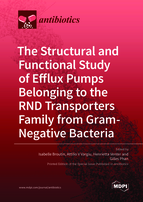The Structural and Functional Study of Efflux Pumps Belonging to the RND Transporters Family from Gram-Negative Bacteria
A special issue of Antibiotics (ISSN 2079-6382). This special issue belongs to the section "Mechanism and Evolution of Antibiotic Resistance".
Deadline for manuscript submissions: closed (30 November 2021) | Viewed by 34240
Special Issue Editors
Interests: efflux pumps;structure;antibiotic resistance;membrane proteins
Interests: efflux pumps;molecular dynamics;enhanced-sampling methods;molecular docking;hydrogels
Interests: antimicrobial resistance; drug efflux proteins; novel antibiotics; mechanisms of resistance; multidrug resistance
Special Issues, Collections and Topics in MDPI journals
Special Issue Information
Dear Colleagues,
Antimicrobial-resistant bacterial infections are a major and costly public health concern. Several pathogens are already pan-resistant, representing a major cause of mortality in patients suffering from nosocomial infections. Drug efflux pumps, which remove compounds from the bacterial cell, thereby lowering antimicrobial concentration to subtoxic levels, play a major role in multidrug resistance.
Gram-negative bacteria are particularly resistant, and some are identified by the World Health Organization as the most urgent priority of pathogens in need of new antimicrobial drug discovery. The clinically most relevant efflux pumps in Gram-negative bacteria belong to the RND (resistance nodulation cell division) family that forms a tripartite macromolecular assembly spanning both membranes and the periplasmic space of Gram-negative organisms. Along with functional studies and in silico approaches, many structures of the individual components, as well as that of the fully assembled pumps from several pathogens, have been solved. Nevertheless, a lot of questions concerning the assembly and the mechanism of efflux remain, and there are still no inhibitors of efflux pumps available in clinical treatment.
In this Special Issue, we would like to present up-to-date knowledge of the mechanism of these efflux pumps, the identification and characterization of RND efflux pumps from emerging pathogens and their role in antimicrobial resistance, as well as progress made on the development of specific inhibitors (including the development of in vitro or in vivo tools for inhibitor selection). This collection of data could serve as a basis for antimicrobial drug discovery aimed at inhibiting drug efflux pumps to reverse resistance in some of the most resistant pathogens.
Dr. Isabelle Broutin
Prof. Attilio V Vargiu
Prof. Dr. Henrietta Venter
Dr. Gilles Phan
Guest Editors
Manuscript Submission Information
Manuscripts should be submitted online at www.mdpi.com by registering and logging in to this website. Once you are registered, click here to go to the submission form. Manuscripts can be submitted until the deadline. All submissions that pass pre-check are peer-reviewed. Accepted papers will be published continuously in the journal (as soon as accepted) and will be listed together on the special issue website. Research articles, review articles as well as short communications are invited. For planned papers, a title and short abstract (about 100 words) can be sent to the Editorial Office for announcement on this website.
Submitted manuscripts should not have been published previously, nor be under consideration for publication elsewhere (except conference proceedings papers). All manuscripts are thoroughly refereed through a single-blind peer-review process. A guide for authors and other relevant information for submission of manuscripts is available on the Instructions for Authors page. Antibiotics is an international peer-reviewed open access monthly journal published by MDPI.
Please visit the Instructions for Authors page before submitting a manuscript. The Article Processing Charge (APC) for publication in this open access journal is 2900 CHF (Swiss Francs). Submitted papers should be well formatted and use good English. Authors may use MDPI's English editing service prior to publication or during author revisions.
Keywords
- Antimicrobial resistance
- RND transporters
- Drug transport
- Efflux pump
- Structural biology
- Molecular dynamics
- Liposome
- In cellulo measurement
- Efflux pump inhibitor










